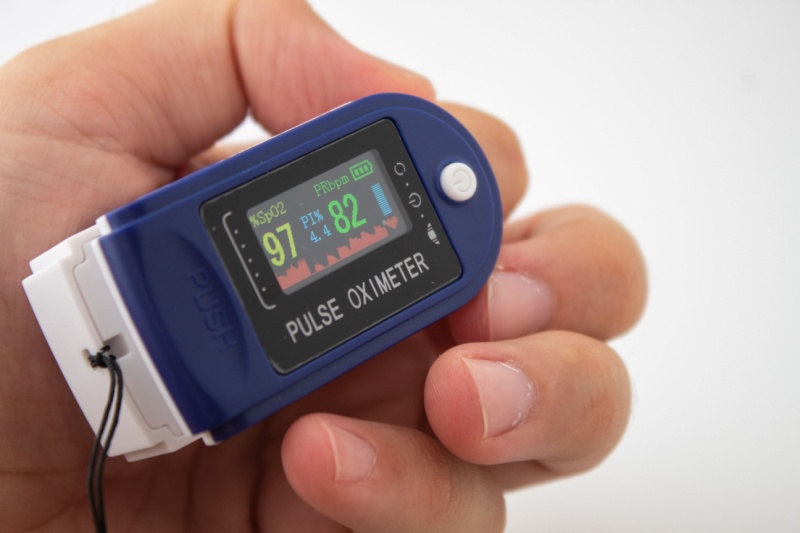The oxygen saturation level is a marker that confirms that the organs and tissues are receiving enough oxygen to maintain bodily functions. It is useful in establishing the severity and diagnosis of heart diseases and can have prognostic implications (the ability to predict the outcome of heart disease). Low levels of oxygen (SpO2 level <93%) can bring about severe complications, especially in the case of heart disease.
What you need to know:
- What is blood oxygen saturation?
- Types of blood oxygen tests
- Need for blood oxygen tests
- SpO2 level and heart health
What is blood oxygen saturation?
Blood oxygen saturation is the amount of oxygen present in your blood. As you inhale air, the oxygen passes through your lungs and into the bloodstream. Then, it is transported to different cells in your body, which use the oxygen efficiently to create energy. Since a healthy body will have optimum blood saturation levels, monitoring blood saturation is common for critical patients such as those with heart disease. An unhealthy heart may prevent proper oxygen absorption, leading to low oxygen levels in the blood (or hypoxemia). Hypoxemia can cause further damage to the heart and other organs.
Types of blood oxygen tests
Blood oxygen level tests can be done in one of the 2 following ways:
Blood draw test:
Healthcare officials often draw blood to perform an oxygen level test as part of a larger test called arterial blood gas (ABG). This test measures the level of carbon dioxide and oxygen in the blood as well as its pH balance.
Pulse oximetry:

Pulse oximetry uses a pulse oximeter to determine the blood oxygen level in your body and the pulse rate. It’s a quick way to check your SpO2 level, and it can be performed anywhere without the help of healthcare providers. A pulse oximeter is clipped to your finger or toe to determine your heart rate and SpO2 level.
Need for blood oxygen tests
Blood oxygen or SpO2 level is an important marker in case of several illnesses and underlying conditions. It helps determine the impact of illness and injuries on the body and monitor and maintain blood oxygen levels when managing or treating a condition. Blood oxygen tests are used in the following situations:
- If you have difficulty breathing
- To determine the impact of infections like COVID-19 and pneumonia
- In case of a head or neck injury
- In the case of carbon monoxide poisoning
- Multiple episodes of nausea and vomiting
- If there is a smoke inhalation injury
- In case of a drug overdose
- While managing pulmonary conditions like asthma, COPD, or fibrosis
- In case of heart disease
- Guiding treatment decisions
- Evaluating exercise and performance
- Pre and post-operative care
SpO2 level and heart health
A blood oxygen level test does not indicate specific conditions but determines their impact or the possibility of certain illnesses when symptoms show. A blood oxygen level test may be useful in certain heart conditions:
Angina

Angina is characterized by pain or discomfort in the chest due to the lack of oxygen-rich blood passing through the heart muscle. It can cause the heart to beat faster to draw more oxygen by diverting it from other organs, causing SpO2 levels to fall. Heart rate may also decrease due to angina, which can cause low SpO2 levels in the body.
Myocarditis
Myocarditis is inflammation of the heart muscles that affects the heart’s ability to pump blood effectively. This leads to decreased blood flow to the other organs, reducing blood oxygen levels in the body. It can also result in arrhythmia, causing blood oxygen levels to fall.
Heart attack
A heart attack occurs when blood flow to the heart is blocked, and the heart muscle is damaged. Blocked blood flow means less oxygen entering the heart which may reduce blood oxygen levels in the body. The heart beats faster and tries to pump more blood by diverting oxygen from other body parts to the heart. This can cause SpO2 levels to fall.
Although blood oxygen level is a critical marker in managing heart disease, it should not be solely relied on when managing heart conditions. Seek help if SpO2 levels drop or other symptoms appear even with normal SpO2 levels.
Stay tuned to the Activ Living Community. Keep up to date with the latest health tips and trends through expert videos, podcasts, articles, and much more on nutrition, fitness, mindfulness, and lifestyle conditions like Asthma, Blood Pressure, Cholesterol, and Diabetes. Activ Living ke saath sahi sehat ki shuruat ABHI karo.
You may also be interested in the following blogs:
Popular Searches
How to lower blood pressure | Fruits good for liver | Unhealthy foods | Ragi Benefits | Basal Metabolic Rate | Acupressure points for High Blood Pressure | Ayurvedic medicine for blood pressure | How to control cholesterol at home | Homeopathy for Asthma | Biological Age | Home remedies for TB | Natural beta blockers | Negative effects of internet | Types of walking | Blood pressure calculator | Blood sugar calculator | BMI Calculator





 1800-270-7000
1800-270-7000











